
I was pretty sure that a 2002 poster campaign run by the Economist misused the phrase "Can't see the wood for the trees". So I wrote to their letters page. I got a reply referring me to Brewer's Concise Phrase and Fable, which I reckoned they had also misinterpreted, so I wrote back. It is interesting that while the dictionaries usually say what is meant by the expressions, they don't describe scene being set. The Economist ran a followup campaign in 2003, that included this poster, which I have to say I'd agree with.
One reason I was so sure about my point is because I discovered this phrase exists in other languages, but is only ambiguous in English. If this phrase translates directly into an idiom of another language, please let me know, so I can add it to the list below. I've also discovered a bit more about the history of the expression in English.
一叶障目 不见泰山
which means "One can not see TaiShan
Mountain because a leaf blocks one's eyes".
ﭼﺸﻢ
ﺩﻳﺪﻥ
ﭼﻮﺏ
ﺑﺮ
ﺗﻦ
ﺩﺭﺧﺗﺎﻥ
ﺟﻨﮕﻞ
ﺭﺍ
ﻧﺪﺍﺭﻧﺪ
However, this expression didn't seem natural to another
speaker, though it did incorporate some elements of an
expression known to them.
In my reply I mentioned the expression as possibly having originated with Weiland in the 1700s, as several web pages suggested this was the case. However, it seems the expression is older than this.
Someone pointed me at another reference to the expression on the web, saying it was listed in a John Heywood's list of proverbs, originally printed in 1546. You don't want to believe everything you read on the web, so I made a trip to the library. I found two reprints of this book, one from 1874 and one from 1906. The phrase is about half way through Part II, Chapter IV.
The first reprint is:
The Proverbs of John Heywood, Beging the "proverbs" of that author printed 1546 Edited, with notes and introduction, by Julian Sharman. London 1874.
It contains the expression as follows, where I believe the italics are supposed to show which bits are proverbs and which bits are filler text by John Heywood.
Plentie is no daintie, ye see not your owne ease. I see, you cannot see the wood for the trees.This references a footnote, that says:
13 you cannot see the wood for the trees, continued proverbial, being found in an anti-popish tract of the reigh of Charles II For him who sees no wood for the trees and yet is busie as the bees... A Letany for S Omers 1682.
The second reprint is:
A dialogue of the effectual proverbs in the English Tongue concerning marriage by John Heywood, Edited by John S. Farmer. MCMVI
The introduction of this reprint is critical of Sharman's reprint, claiming it is inaccurate and is missing some lines. This edition does claim to modernise the spelling and formatting of the text. Its version of the expression is:
Plenty is no dainty, ye see not your own ease, I see ye cannot see the wood for the trees
the index includes a mention of the same anti-popish treaty, but says it is "From he..." rather than "For he...", so there are minor differences between the two versions, but "the wood for the trees" is intact in both. The Early English Books Online database also have scans of early editions of this book, with the text (as best I can read it - it uses fonts no longer commonly used for English):
Plentie is no deyntie. ye see not your owne ease. I see, ye can not see the wood for trees.
This all suggests it may well have been in the original, making the expression over 400 years old. (Another early reference is supposed to occur in Brian Melbancke's in Philotimus (1583?) saying: 'Thou canst not or wilt not see wood for trees.' I haven't managed to track this down in a library yet, though it is in EEBO.)
However, it seems that this is not the beginning of the story. Using EEBO, I found that in "The second parte of the co[n]futacion of Tyndals answere in whyche is also confuted the chyrche that Tyndale deuyseth. And the chyrche also that frere Barns deuyseth." which is "Made by syr Thomas More knyght." on a page labelled "ccccxxxvii" at the end of the second paragraph we have
And then we may well tell hym agapne, thet he can not se the wood for the trees.The copy in EEBO is dated 1533, which pushes us back another ten years or so before most of the dictionaries know of a reference. Note, this is the same Thomas More who was executed by Henry VIII.
The 20 volume version of the OED also has a reference to Heywood's book, under the entry for "wood". From the point of view of understanding the expression, it is worth noting that this proverb is included under the part of the definition corresponding to "wood means a forest" not "wood is a material coming from trees".
Another interesting thing brought up by the OED entry for wood, is that at one stage the word "wood" could mean the same as "tree". From the examples given in the OED, it looks like this usage may have still been understood at John Heywood's time. This might have given the expression a clever nonsense interpretation, which is lost on us today.
Google has a tool called Google Ngram Viewer, which lets you search for sequences of words in Google books and see their relative frequency. After fumbling around for a bit, I managed to get the following results.
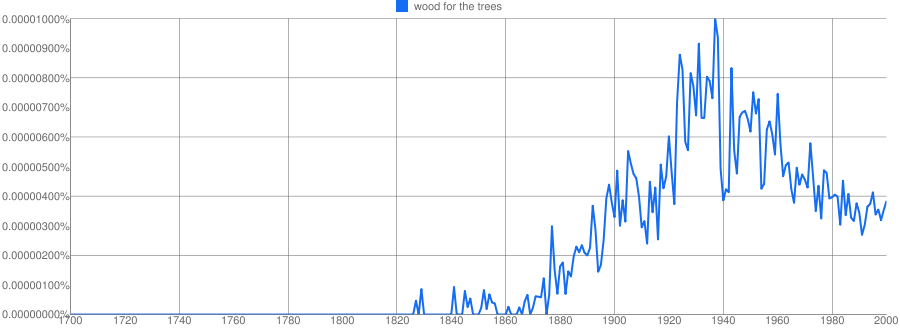
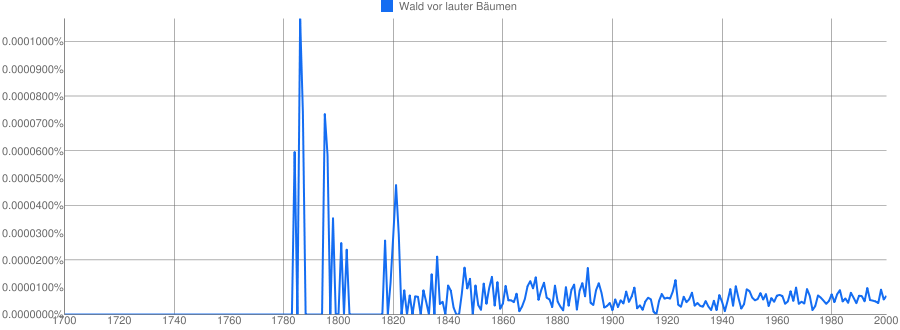
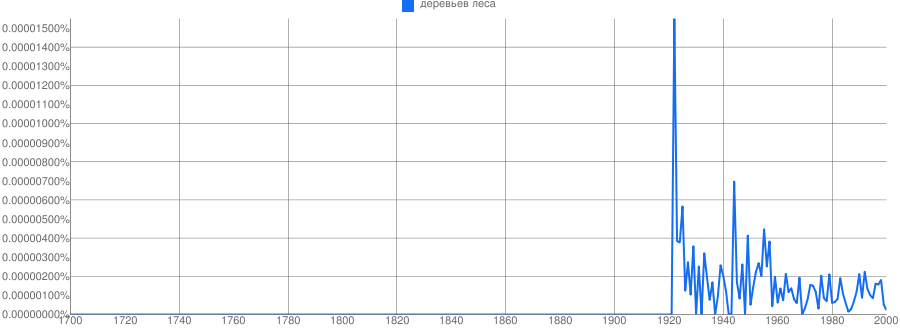
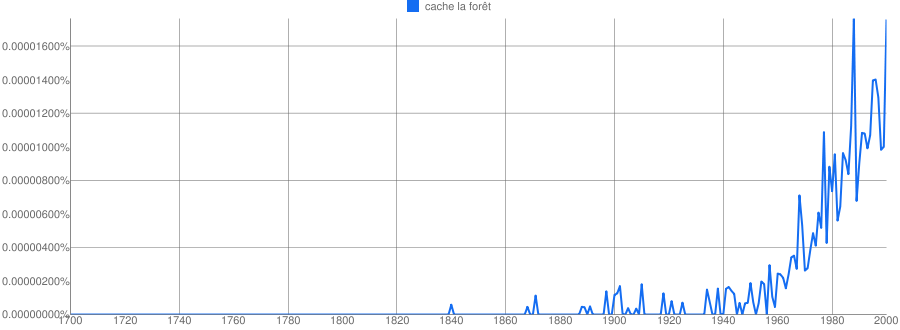
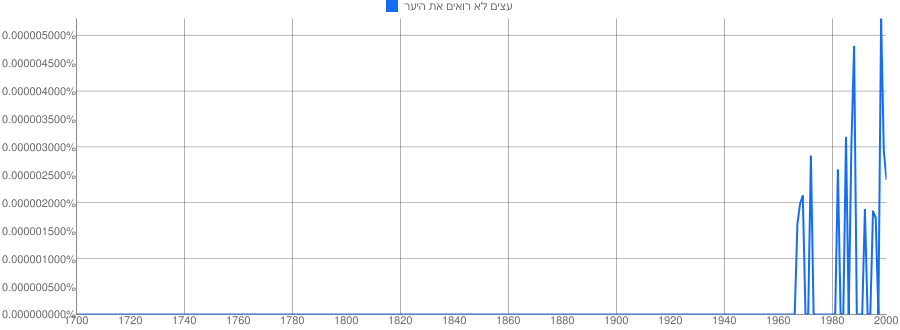
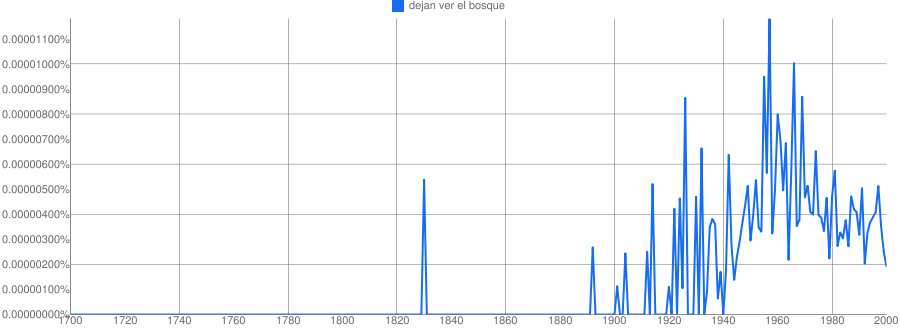
So, Google first finds the phrase in German in about 1780, which overlaps in a plausible way with Wieland. It doesn't find anything in English until the 1820s, which tells us that either Google doesn't have coverage prior to this, or the spellings/phrasing used before this isn't the same (for example, I get a few earlier hits on "wood for trees"). French kicks off in 1840, Spanish - after a blip about 1830 gets going about 1900, Russian in 1920 and Hebrew in 1970. It's quite possible that either Google's coverage or variant forms make these results a bit undependable though. You can retry the searches in English, German, French, Hebrew, Russian and Spanish.
Note, it seems it is possible to do better, if you know how the languages better. For example, here is an example of finding the Russian phrase back to the 1860s.
To: letters@economist.com
Subject: Can't see the...
Date: Wed, 05 Jun 2002 14:28:12 +0100
The Economist is currently running a poster campaign in Ireland.
One of posters shows a small group of trees and a log. Below the
trees is written "The Trees" and below the log is written "The
Economist". A photograph of this poster is available at
http://www.maths.tcd.ie/~dwmalone/wood-for-trees.jpg
I presume that the phrase that is being alluded to is "Can't see the
wood for the trees", and the implication is that reading The Economist
will allow you to see the wood (ie., the log).
Unfortunately, this expression means "cannot see the big picture"
and "the wood" actually refers to a small forest! This can be
confirmed by checking a dictionary or by looking at the equivalent
expressions in Dutch "Je kunt door de bomen het bos niet meer zien"
(you can no longer see the forest through the trees), French
"L'arbre qui cache la foret" (the tree which hides the forest)
or other languages.
I presume that the poster is not suggesting that The Economist is
hiding the big picture from its readers. More likely, the advertisers
didn't check the poster carefully with your good selves; a case of
the left hand not knowing what the right hand is doing.
David.
To: Jacqui Kean
Subject: Re: Your letter to the editor
In-reply-to: Your message of "Thu, 06 Jun 2002 15:49:09 BST."
<scff847d.011@UKLOTWS03.ECONOMIST.COM>
Date: Sun, 30 Jun 2002 20:33:58 +0100
Sorry for the delay in replying to your mail, but I have been busy
for the last couple of weeks. You replied to me regarding the
poster depicting "the wood from the trees".
> In reply, could I refer you to :
> Brewer's Concise Phrase and Fable, Cassell & Co. (first published 1870,
> reprinted 2000.)p 1104.
> "One can't see the wood for the trees. It is difficult to pick out the
> essentials from the surrounding mass of detail; the main issues are not
> readily apparent."
Indeed - I would concur with Brewer's Concise Phrase and Fable.
Unfortunately, it does not clearly state the image being invoked.
To try to clarify the issue, I have looked up the phrase in a number
of dictionaries and I have included the results at the end of this
mail. I believe the entry from the OED is particularly revealing:
to be unable to see the wood (or N. America the forest) for
the trees: fail to grasp the main issue because of
over-attention to details
but the others help illuminate the spirit of the phrase.
> Clearly The Economist, depicted as the wood, represents the main issues
> extracted from the mass of detail.
The problem is that the Economist is not being depicted as the wood
- - it is being presented as a log! As I commented in my original
mail, "the wood" refers to a forest in this expression. It is
unfortunate that the Economist was represented as a log, because
it can be willfully misinterpreted as an even more trivial detail
than "the trees" of which the wood consists.
> I wouldn't consider commenting on the origin of the phrase when translated
> into foreign languages, since the ad was designed only for the UK market.
Some time has passed since Dublin, where I saw these posters, was
in was a part of the UK. The Irish language seems to have no
equivalent expression. The expression came into use in the 1700s,
possibly originating from the German poet Christoph Martin Weiland,
a time of decline for Irish. Thus the phrase may never have made
it from German to Irish, a transition which it clearly made for
many other languages (including English). The 1700s were also a time
of deforestation in Ireland, which perhaps made the phrase less
relevant ;-)
> With regard to your final point, at The Economist we work closely with all
> of our agencies in the development of advertising and other marketing
> communications. In other words, both hands are well aware of the others'
> activity.
Excellent - then I can help all of you in telling the wood from the logs.
David.
The Concise Oxford Dictionary (10th Edition):
wood: ... be unable to see the wood (or N. America the forest) for
the trees: fail to grasp the main issue because of over-attention
to details ....
Penguin Dictionary of English Idioms (1st edition 2000):
P50 Wood: 14. not to see the wood for the trees -
not to be able to make out the essential because of all the detail.
'You have put in so much unnecessary detail that one looses track
of the story; one can't see the wood for the trees.'
Penguin Dictionary of Quotation (2nd edition 2001):
Wood for the Trees: See Big Picture
Big Picture: To see the big picture is to have the ability to taken
an overview and to see everything in its place. It is the opposite
of 'can't see the wood for the trees' (an expression in use since
the 16th century). This use of 'Big Picture' is a recent one, the
expression having previously been used of the main feature in the
days when more than one film was shown in a programme at the cinema.
The World Book Dictionary (1994):
wood: ... not to see the wood for the trees, to loose the view of
the whole in the multitude of details ...
Collins Plain English Dictionary (1996):
wood: ... If you can't see the wood for the trees, you are so
involved with the details of a situation or activity that you can
not see or understand its general purpose of important features.
Cassel's Engligh Dictionary (1998):
wood: ... To be prevented by excessive detail from getting an overall
view.